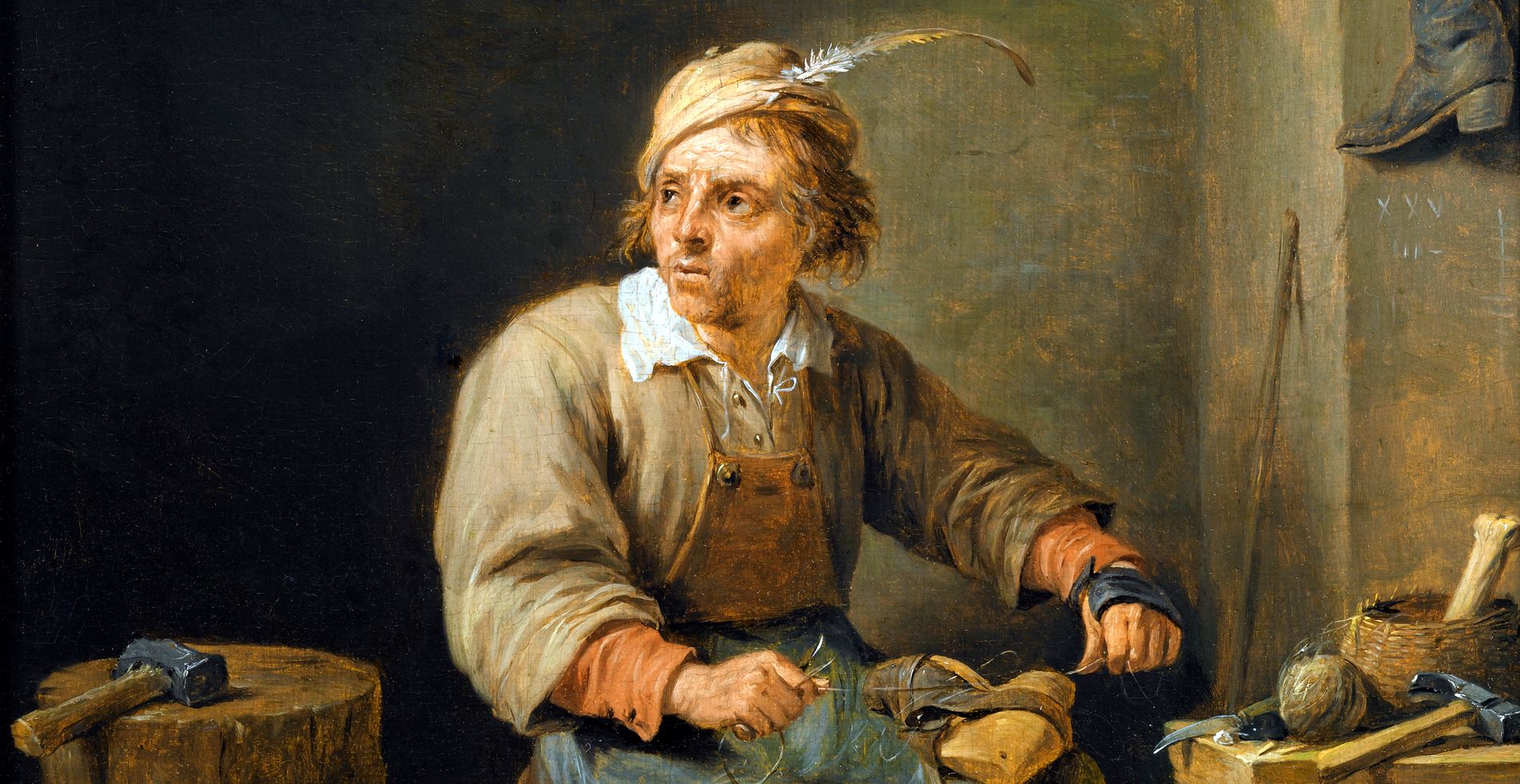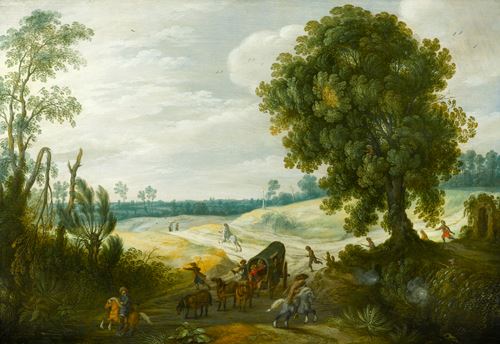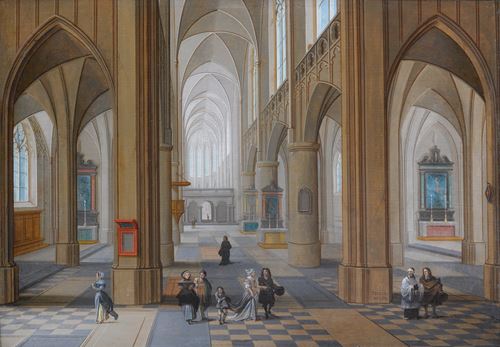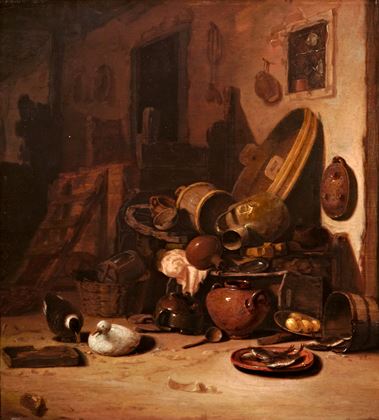avid Teniers II
(Antwerp 1610 - Brussels 1690)
A Cobbler in his Workshop
signed and dated ‘D: TENIERS · FEC A 1671’ (lower right, on the work bench)
oil on canvas
37.2 x 28 cm (14⅝ x 11 in)
In this fine example of David Teniers II’s genre scenes, a cobbler sits in his workshop, surrounded by the tools of his trade. A leather band, held taut by his foot and his knee, holds the shoe tightly against his left thigh, which frees both the cobbler’s hands to sow the leather upper to the sole. However, he has paused in his work and turns away distractedly, and his pursed lips suggest he is whistling. His pose is echoed by the jaybird perched high above his left shoulder, and a linnet is kept in a cage on the other side of the workshop. It is perhaps this latter bird, to whom the cobbler directs his whistle. The figure is portrayed less as an artisan and more as a labourer. His clothes are grubby despite the leather apron protecting them, his face is swarthy and unshaven, and his flaxen hair is long and unkempt. He is surrounded by discarded shoes and his tools, which include a hammer, knife, awl, and even a bone which serves as a bobbin to wind his thread. The work presents a delightful juxtaposition, as Teniers depicts this coarse toiling craftsman, delicately whistle to his pet bird.
A Cobbler in his Workshop work was engraved and published by the noted French engraver Jacques-Philippe Le Bas (1707-1783) in 1744, under the title Le Sifleur de Linote (‘The Whistle of the Linnet’). Underneath the engraving was a poem by Moraine, in which he imagines the cobbler’s thoughts:
‘Quand sans avoir appris ni musique, ni note, Ton flexible gosier imite en tous leurs tons Mes joyeux siflements, mes gaillardes chansons, Je me sens tout ravi, ma petite Linote.
Ah, je t’aime bien mieux que ma femme Alison, Qui jamais avec moy ne fut à l’uni-son, Et qui ne manque point dans son humeur bizarre, Si je chante en Bé mol, de chanter en Bé quarre.’
(‘When, without having learned neither music or notes, your flexible throat mimics in all their tones my merry whistling, my bawdy songs, I feel very happy, my little Linnet.
Ah, I love you much better than my wife Alison, who is never with me in unison, and who never fails to be in a strange mood, whether I sing in B flat, or in B natural.’)
This humorous interpretation of the scene adds another dimension to a modern viewer’s enjoyment of A Cobbler in his Workshop. Le Bas was a passionate pupil of Teniers’ work, holding him up as an exemplar for his students to study, and he himself engraved over 100 of Teniers’ paintings.
A Cobbler in his Workshop is a characteristic example of Teniers’ work. Throughout his long career he delighted in depicting the daily lives of the Flemish peasant, a comparable example being Pipesmokers in an Inn (Private Collection). Both works are from the early 1670s, and demonstrate the looser and more painterly style which Teniers favoured in his mature period. In Pipesmokers in an Inn, each figure is highly individualised, as one smoker sucks purposefully on his pipe, whilst the other offers a toothless but contented grin. This talent for psychological characterisation, and his astute observation of facial expressions and body language, is something that Teniers also displays in the portrayal of the distracted cobbler in the present work.
Many of Teniers’ peasant scenes take place in taverns, centred around smoking and drinking. This is also the case in the Mauritshuis’ Peasants in a Tavern, which is compositionally comparable to A Cobbler in his Workshop. Although there is a secondary figure warming himself by the fire, the focus of the work is very much on the old man, who is prominently positioned in the centre foreground, much like the cobbler in the present work. In both works Teniers emphasises this central positioning by placing the figure where light meets shadow, and so his protagonist is accentuated against the darkness. This simple composition allows Teniers to fully dedicate the work to a character study of a highly individualised peasant, and the surrounding details serve to contextualise and enliven the subject. Although the Mauritshuis’ painting does depict Tenier’s favoured themes of drinking and smoking, both it and A Cobbler in his Workshop are very different in mood from the more clustered and bawdy peasant scenes which he often depicted. Painted in 1671, the present work represents Teniers’ artistic maturity, and as Hans Vlieghe has commented ‘In many of Teniers’s late paintings, the hustle and bustle of the peasant kermis is gradually supplanted by simple, tranquil scenes with very few – often just one or two – human figures.’1
By the 1720s ‘ Teniers’s work was ranked in Paris among the most highly esteemed collectors’ items’, and A Cobbler in his Workshop seems to have been a renowned work, partly due to its dissemination through engravings.² The painting was also to prove a source of inspiration for a number of eighteenth-century French artists, perhaps most notably Jean-Siméon Chardin (1699-1779). Dietmar Lüdke suggests a direct connection between A Cobbler in his Workshop and one of Chardin’s most famous works, the Louvre’s La Serinette, which shows a woman teaching her canary to sing.³ As Lüdke points out, the works not only share thematic similarities, but also compositional ones. A Cobbler in his Workshop even influenced artists working in different mediums, for example the sculptor Paul Louis Cyfflé (1724-1806) produced the porcelain Cobbler Whistling to his Starling, which clearly derives from the present work.
Teniers was born in Antwerp in 1610, the son of a painter and art dealer of the same name. His father painted small scale history paintings, and served as Teniers’ first teacher. Having served his apprenticeship he became a master of the Antwerp Guild of St. Luke in 1632-33, and in 1637 he joined Antwerp’s most famous artistic dynasty, by marrying Anna, daughter of Jan Breughel I.
From early in his career Teniers had excellent relationships with Antwerp’s art dealers, who greatly prized the genre paintings with which he quickly established his reputation. Although in this early work he absorbed a number of influences, ‘The most lasting impression, however, was made by Adriaen Brouwer’s (1605/6-1638) paintings of excited simple folk’.⁴ Brouwer spent the last period of his life in Antwerp and his pictures of the daily lives of peasants proved hugely influential for Teniers. However, the work of the two artists are compared, there are clearly significant differences. Brouwer’s figures tend to be very direct, expressive and animated. In contrast to these, Teniers’ work tends to have a comparative calmness and composure. As Klinge says ‘his artistic individuality, unlike Brouwer’s, resides precisely in his almost still-life-like handling of figures and spaces’.⁵
Teniers soon became one of the most successful painters in Antwerp, and attracted several prestigious commissions. By the 1640s he had prospered to the extent that he was able to rent a large manor house, and in 1645 he became the Dean of the Guild of St. Luke. In 1647 he received his first commission from the newly appointed Governor of the Southern Netherlands, Archduke Leopold Wilhelm (1616-1662), and court painter and court painter four years later. This appointment meant he was responsible for expanding the Archduke’s picture collection, which saw him travelling to England. Teniers captured the collection in several gallery pictures as well as an illustrated catalogue Theatrum Pictorium (1660). After the Archduke left Brussels, Teniers stayed on as Court Painter to the new governor, Don Juan of Austria, and he also worked for Philip IV of Spain and Willem II of the Northern Netherlands. He continued to have great success and led an aristocratic lifestyle. He died in Brussels but his legacy continued to prove enormous influential to future generations of artists.
¹ Vlieghe, H., David Teniers the Younger (1610-1690): A Biography, (Brepols, Turnhout, 2011), p. 71. ² Ibid, p.104. ³ Jean Siméon Chardin, 1699–1779: Werk, Herkunft, Wirkung, Exh. cat., Staatliche Kunsthalle Karlsruhe. Karlsruhe, 1999, p. 348. ⁴ Klinge, M., ‘Introduction’ in David Teniers the Younger: Paintings, Drawings, exh. cat., Koninklijk Museum voor Schone Kunsten, Antwerp, May-Sept 1991, p.16. ⁵ Ibid. p. 18.
Jean-Louis Henri Orry seigneur de Fulvy, de Mareuil et de Villiers-les-Hauts (1703-1751);
The Preyer Collection, The Hague, 1927;
anonymous sale, Hôtel Drouot, Paris, 16 December 1981, lot 21;
with Galerie Michel Ségoura, Paris.
Stuart G. Davis, ‘Some English Pottery and Porcelain Figures Connected with Alsace and Lorraine’, in The Burlington Magazine for Connoisseurs, vol. 51, no. 296 (November 1927), p.222;
Jean Siméon Chardin, 1699–1779: Werk, Herkunft, Wirkung, Exh. cat., Staatliche Kunsthalle Karlsruhe. Karlsruhe, 1999, p. 348;
Peter Hecht, ‘Art Beats Nature, and Painting does so Best of All: The Paragone Competition in Duquesnoy, Dou and Schalcken’ in Simiolus: Netherlands Quarterly for the History of Art, vol. 29, no. ¾ (2002), p. 191;
The Middle - Tom Ellis at the Wallace Collection, exh. cat., The Wallace Collection, London, September - November 2016, p. 12 (illustrated).
Engraved: Jacques Philippe Le Bas, Le Sifleur de Linote, 1744;
Giovanni Marco Pitteri, Le Cordonnier.
In this fine example of David Teniers II’s genre scenes, a cobbler sits in his workshop, surrounded by the tools of his trade. A leather band, held taut by his foot and his knee, holds the shoe tightly against his left thigh, which frees both the cobbler’s hands to sow the leather upper to the sole. However, he has paused in his work and turns away distractedly, and his pursed lips suggest he is whistling. His pose is echoed by the jaybird perched high above his left shoulder, and a linnet is kept in a cage on the other side of the workshop. It is perhaps this latter bird, to whom the cobbler directs his whistle. The figure is portrayed less as an artisan and more as a labourer. His clothes are grubby despite the leather apron protecting them, his face is swarthy and unshaven, and his flaxen hair is long and unkempt. He is surrounded by discarded shoes and his tools, which include a hammer, knife, awl, and even a bone which serves as a bobbin to wind his thread. The work presents a delightful juxtaposition, as Teniers depicts this coarse toiling craftsman, delicately whistle to his pet bird.
A Cobbler in his Workshop work was engraved and published by the noted French engraver Jacques-Philippe Le Bas (1707-1783) in 1744, under the title Le Sifleur de Linote (‘The Whistle of the Linnet’). Underneath the engraving was a poem by Moraine, in which he imagines the cobbler’s thoughts:
‘Quand sans avoir appris ni musique, ni note, Ton flexible gosier imite en tous leurs tons Mes joyeux siflements, mes gaillardes chansons, Je me sens tout ravi, ma petite Linote.
Ah, je t’aime bien mieux que ma femme Alison, Qui jamais avec moy ne fut à l’uni-son, Et qui ne manque point dans son humeur bizarre, Si je chante en Bé mol, de chanter en Bé quarre.’
(‘When, without having learned neither music or notes, your flexible throat mimics in all their tones my merry whistling, my bawdy songs, I feel very happy, my little Linnet.
Ah, I love you much better than my wife Alison, who is never with me in unison, and who never fails to be in a strange mood, whether I sing in B flat, or in B natural.’)
This humorous interpretation of the scene adds another dimension to a modern viewer’s enjoyment of A Cobbler in his Workshop. Le Bas was a passionate pupil of Teniers’ work, holding him up as an exemplar for his students to study, and he himself engraved over 100 of Teniers’ paintings.
A Cobbler in his Workshop is a characteristic example of Teniers’ work. Throughout his long career he delighted in depicting the daily lives of the Flemish peasant, a comparable example being Pipesmokers in an Inn (Private Collection). Both works are from the early 1670s, and demonstrate the looser and more painterly style which Teniers favoured in his mature period. In Pipesmokers in an Inn, each figure is highly individualised, as one smoker sucks purposefully on his pipe, whilst the other offers a toothless but contented grin. This talent for psychological characterisation, and his astute observation of facial expressions and body language, is something that Teniers also displays in the portrayal of the distracted cobbler in the present work.
Many of Teniers’ peasant scenes take place in taverns, centred around smoking and drinking. This is also the case in the Mauritshuis’ Peasants in a Tavern, which is compositionally comparable to A Cobbler in his Workshop. Although there is a secondary figure warming himself by the fire, the focus of the work is very much on the old man, who is prominently positioned in the centre foreground, much like the cobbler in the present work. In both works Teniers emphasises this central positioning by placing the figure where light meets shadow, and so his protagonist is accentuated against the darkness. This simple composition allows Teniers to fully dedicate the work to a character study of a highly individualised peasant, and the surrounding details serve to contextualise and enliven the subject. Although the Mauritshuis’ painting does depict Tenier’s favoured themes of drinking and smoking, both it and A Cobbler in his Workshop are very different in mood from the more clustered and bawdy peasant scenes which he often depicted. Painted in 1671, the present work represents Teniers’ artistic maturity, and as Hans Vlieghe has commented ‘In many of Teniers’s late paintings, the hustle and bustle of the peasant kermis is gradually supplanted by simple, tranquil scenes with very few – often just one or two – human figures.’1
By the 1720s ‘ Teniers’s work was ranked in Paris among the most highly esteemed collectors’ items’, and A Cobbler in his Workshop seems to have been a renowned work, partly due to its dissemination through engravings.² The painting was also to prove a source of inspiration for a number of eighteenth-century French artists, perhaps most notably Jean-Siméon Chardin (1699-1779). Dietmar Lüdke suggests a direct connection between A Cobbler in his Workshop and one of Chardin’s most famous works, the Louvre’s La Serinette, which shows a woman teaching her canary to sing.³ As Lüdke points out, the works not only share thematic similarities, but also compositional ones. A Cobbler in his Workshop even influenced artists working in different mediums, for example the sculptor Paul Louis Cyfflé (1724-1806) produced the porcelain Cobbler Whistling to his Starling, which clearly derives from the present work.
Teniers was born in Antwerp in 1610, the son of a painter and art dealer of the same name. His father painted small scale history paintings, and served as Teniers’ first teacher. Having served his apprenticeship he became a master of the Antwerp Guild of St. Luke in 1632-33, and in 1637 he joined Antwerp’s most famous artistic dynasty, by marrying Anna, daughter of Jan Breughel I.
From early in his career Teniers had excellent relationships with Antwerp’s art dealers, who greatly prized the genre paintings with which he quickly established his reputation. Although in this early work he absorbed a number of influences, ‘The most lasting impression, however, was made by Adriaen Brouwer’s (1605/6-1638) paintings of excited simple folk’.⁴ Brouwer spent the last period of his life in Antwerp and his pictures of the daily lives of peasants proved hugely influential for Teniers. However, the work of the two artists are compared, there are clearly significant differences. Brouwer’s figures tend to be very direct, expressive and animated. In contrast to these, Teniers’ work tends to have a comparative calmness and composure. As Klinge says ‘his artistic individuality, unlike Brouwer’s, resides precisely in his almost still-life-like handling of figures and spaces’.⁵
Teniers soon became one of the most successful painters in Antwerp, and attracted several prestigious commissions. By the 1640s he had prospered to the extent that he was able to rent a large manor house, and in 1645 he became the Dean of the Guild of St. Luke. In 1647 he received his first commission from the newly appointed Governor of the Southern Netherlands, Archduke Leopold Wilhelm (1616-1662), and court painter and court painter four years later. This appointment meant he was responsible for expanding the Archduke’s picture collection, which saw him travelling to England. Teniers captured the collection in several gallery pictures as well as an illustrated catalogue Theatrum Pictorium (1660). After the Archduke left Brussels, Teniers stayed on as Court Painter to the new governor, Don Juan of Austria, and he also worked for Philip IV of Spain and Willem II of the Northern Netherlands. He continued to have great success and led an aristocratic lifestyle. He died in Brussels but his legacy continued to prove enormous influential to future generations of artists.
¹ Vlieghe, H., David Teniers the Younger (1610-1690): A Biography, (Brepols, Turnhout, 2011), p. 71. ² Ibid, p.104. ³ Jean Siméon Chardin, 1699–1779: Werk, Herkunft, Wirkung, Exh. cat., Staatliche Kunsthalle Karlsruhe. Karlsruhe, 1999, p. 348. ⁴ Klinge, M., ‘Introduction’ in David Teniers the Younger: Paintings, Drawings, exh. cat., Koninklijk Museum voor Schone Kunsten, Antwerp, May-Sept 1991, p.16. ⁵ Ibid. p. 18.
Jean-Louis Henri Orry seigneur de Fulvy, de Mareuil et de Villiers-les-Hauts (1703-1751);
The Preyer Collection, The Hague, 1927;
anonymous sale, Hôtel Drouot, Paris, 16 December 1981, lot 21;
with Galerie Michel Ségoura, Paris.
Stuart G. Davis, ‘Some English Pottery and Porcelain Figures Connected with Alsace and Lorraine’, in The Burlington Magazine for Connoisseurs, vol. 51, no. 296 (November 1927), p.222;
Jean Siméon Chardin, 1699–1779: Werk, Herkunft, Wirkung, Exh. cat., Staatliche Kunsthalle Karlsruhe. Karlsruhe, 1999, p. 348;
Peter Hecht, ‘Art Beats Nature, and Painting does so Best of All: The Paragone Competition in Duquesnoy, Dou and Schalcken’ in Simiolus: Netherlands Quarterly for the History of Art, vol. 29, no. ¾ (2002), p. 191;
The Middle - Tom Ellis at the Wallace Collection, exh. cat., The Wallace Collection, London, September - November 2016, p. 12 (illustrated).
Engraved: Jacques Philippe Le Bas, Le Sifleur de Linote, 1744;
Giovanni Marco Pitteri, Le Cordonnier.





 contact
contact +44 20 7313 8040
+44 20 7313 8040









